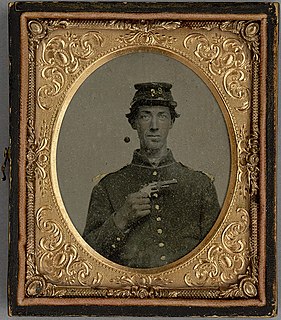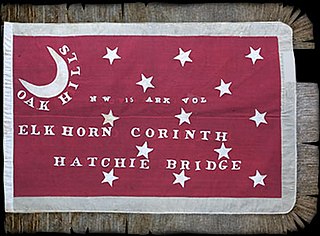The 34th Indiana Veteran Volunteer Infantry Regiment, nicknamed The Morton Rifles, was an Infantry Regiment that served in the Union Army during the American Civil War. It had the distinction of fighting in the last land action of the war, the Battle of Palmito Ranch, Texas May 12–13, 1865, and also of suffering the last soldier killed during the war, Private John J. Williams.
The 7th Regiment, Vermont Volunteer Infantry was a three years' infantry regiment in the Union Army during the American Civil War. It served in the Western Theater, predominantly in Louisiana and Florida, from February 1862 to March 1866. It was the longest serving Vermont regiment during the war.

The 23rd Regiment Wisconsin Volunteer Infantry was an infantry regiment that served in the Union Army during the American Civil War.
The 21st Regiment Iowa Volunteer Infantry was an infantry regiment that served in the Union Army during the American Civil War.
The 26th Indiana Volunteer Infantry Regiment was an infantry regiment that served in the Union Army during the American Civil War.
The 114th Ohio Volunteer Infantry was an infantry regiment in the Union Army during the American Civil War.

Persimmon regiment was a term used during the American Civil War to describe a regiment that, in its history, stopped marching for a brief while to consume persimmons, a type of fruit popular in the Southern United States. Three different regiments in the Union army acquired the nickname.
The 16th Ohio Volunteer Infantry was an infantry regiment in the Union Army during the American Civil War.
The 49th Regiment Indiana Infantry was an infantry regiment that served in the Union Army during the American Civil War.
The 69th Regiment Indiana Infantry was an infantry regiment that served in the Union Army during the American Civil War.
The 67th Regiment Indiana Infantry was an infantry regiment that served in the Union Army during the American Civil War.
The 46th Regiment Indiana Infantry was an infantry regiment that served in the Union Army during the American Civil War.
The 47th Regiment Indiana Infantry was an infantry regiment that served in the Union Army during the American Civil War.
The 16th Regiment Indiana Infantry was an infantry regiment in the Union Army during the American Civil War. In August 1863, the regiment was converted to mounted infantry for the remainder of the war.

The 15th (Northwest) Arkansas Infantry Regiment (1861–1865) was a Confederate Army infantry regiment during the American Civil War. The unit was originally formed as the 3rd Arkansas Infantry Battalion. After receiving the required 10 companies, the unit was redesignated as the 21st (McRae's) Arkansas Infantry Regiment. Upon recognition that there was already a 21st Arkansas, the unit was again redesignated as the 15th Arkansas Infantry Regiment. This was the third Arkansas unit to bear the designation "15th Arkansas". The others are the 15th (Josey's) Arkansas Infantry Regiment and the 15th (Gee/Johnson) Arkansas Infantry Regiment. The unit saw action both west and east of the Mississippi, before serving in the Vicksburg campaign. The regiment was surrendered at Vicksburg in July 1863. After being paroled and exchanged, the regiment was consolidated with other depleted Arkansas regiments to form the 1st (Trans-Mississippi) Arkansas Consolidated Infantry Regiment.
The 12th Arkansas Infantry (1861–1865) was a Confederate Army infantry regiment during the American Civil War. The regiment spent much of its service defending Confederate strong points along the Mississippi River. The unit participated in the defense of Island No. 10 in early 1862 and later became part of the garrison of Port Hudson in 1863. Following the capitulation of the garrison of Port Hudson, the survivors of the 12th were eventually paroled and exchanged back to Arkansas where the regiment was consolidated with the remnants of several other Arkansas regiments to become the 2nd Arkansas Consolidated Infantry Regiment.
The 19th (Dockery's) Arkansas Infantry (1862–1865) was a Confederate Army infantry regiment during the American Civil War. There were two other Arkansas units which were designated as the 19th Arkansas. Dawson's 19th Arkansas Infantry was organized at Nashville, Arkansas, on November 21, 1861. Hardy's Arkansas Infantry Regiment, which is also occasionally referred to as the 19th Arkansas was organized in 1863 from those parts of Dawson's 19th Infantry Regiment, the 24th Arkansas Infantry Regiment and Crawford's Arkansas Infantry Battalion, which escaped capture at the Battle of Arkansas Post.

The 21st Arkansas Infantry (1862–1865) was a Confederate Army infantry regiment during the American Civil War. The unit was organized from the consolidation of two understrength Arkansas units in May 1862. The unit participated in the Iuka-Corinth Campaign before becoming part of the garrison of Vicksburg Mississippi. After the capitulation of Confederate forces at Vicksburg, the 21st was paroled and exchanged back to Arkansas where it was combined with the remnants of several there Arkansas regiments to become the 1st Arkansas Consolidated Infantry Regiment (Trans-Mississippi). Another Arkansas Confederate infantry regiment, commanded by Colonel Dandridge McRae was also labeled the "21st Arkansas". To avoid confusion between two 21st Arkansas Regiments, McRae's regiment was later redesignated as the 15th (Northwest) Arkansas Infantry Regiment.
The 43rd Regiment of Indiana Infantry was a volunteer infantry unit from the U.S. state of Indiana that served in the Union Army during the U.S. Civil War in the Western Theater. Though deployed at different times in support of Federal operations in Missouri, Tennessee, Kentucky and Mississippi, the majority of its combat service took place in Arkansas. During the ill-fated Camden Expedition, it was one of three infantry regiments that, along with the Thirty-sixth Iowa and Seventy-seventh Ohio infantry, comprised the 2nd Brigade of the Third Division commanded by General Frederick Salomon. This division and brigade formed part of the Union VII Corps under Major-General Frederick Steele. A sizable portion of the regiment was killed or captured at the Battle of Marks' Mills on 25 April 1864; the prisoners were sent south to Camp Ford in Tyler, Texas, where eleven of them perished. The remaining elements were transferred northward, and ended their wartime service guarding Confederate prisoners-of-war at Camp Morton in their own home state.

Uriah H. Brown (1841–1927) was a United States soldier who fought with the Union Army during the American Civil War as a member of Company G, 30th Ohio Infantry. He received the Medal of Honor, his country's highest award for bravery during combat, for his actions during the Battle of Vicksburg in Mississippi on 22 May 1863. That award was conferred on August 15, 1894.









